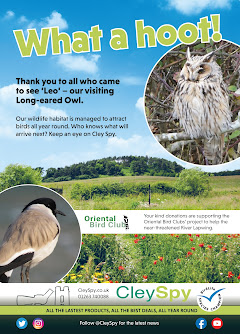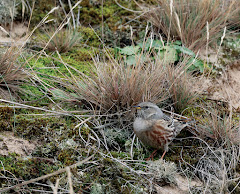"DURING the next few weeks a rich harvest of caterpillars will provide migrant warblers with a good boost to their fat reserves before they take off on their marathon flight to Africa.
However, these offspring of moths and butterflies are equally beautiful in their own right, while many have ingenious devices to protect themselves from predators. As indeed they must in order to perpetuate the species and keep the food chain unbroken.
The long chestnut hairy caterpillar of the drinker moth is unpalatable to most birds, but the cuckoo can devour them with impunity. The smaller vapourer moth larva also has long hair with toothbrush-like bristles on top. One should always be wary of handling hairy caterpillars as they can cause irritation or rashes, especially to youngsters.
A few caterpillars will spend the winter in hibernation sometimes and are only a millimetre or so in length. Most probably pass the winter months as a pupa. These can be a slight chamber made in the earth, attached to a tree or concealed in litter on the ground. The magpie moth larva constructs a silken web to hold the pupa on a plant stem, which hopefully will remain in place for several months.
The pupa of the immigrant convolvulus hawk-moth has a curious bent projection not unlike the handle of a jug and this houses their extra-long tongue with which it can easily sip nectar from nicotiania flowers. Like the other hawk moths it pupates in the ground, but it is unable to survive our winters.
The puss moth caterpillar discovered plastic wood long before man! It eats out a slight hollow in the wood of a tree or branch or even a fence post. It then masticates the wood fragments to form a hard setting chamber in which it will spend the winter months, hopefully unseen by the prying eyes of a tit or woodpecker. How does it escape from its winter prison? In its construction the caterpillar is careful to leave the exit end with a thinner layer of glued together wood. The chrysalis is provided with a cutting tool in the shape of a keel-like implement on the fore part and with this it operates on the weak end until a breach is made. The moth then breaks the head end of the chrysalis and moistens the material with a softening fluid so that the insect can force its way out of the cocoon.
Insects are wonderful! There are roughly 2,000 species of moths in the UK. These are split into two groups known as macros, comprising about 800 species and 1,200 species of minors. Historically, the macro group has received more attention as it includes most of the large moths (but paradoxically it includes many small moths), while the minor group has some larger moths. All very confusing. Also, in the early days, there were not many moth books and most of the minor moths only had their scientific names. All has changed and it is now possible to buy books (or go on the internet) on everything.
This has been, so far, a very erratic season for moths with low numbers of resident hawk moths such as poplar, privet, eyed, elephant and lime hawks. On the other hand there has been good numbers of smaller moths. Since we saw an immigrant humming-bird hawk moth on the early date of April 18, several more have been in or near our garden visiting flowers of valerian. On June 24 we saw another visiting lavender flowers near the Princess Theatre in Hunstanton.
PETER CLARKE"








































No comments:
Post a Comment